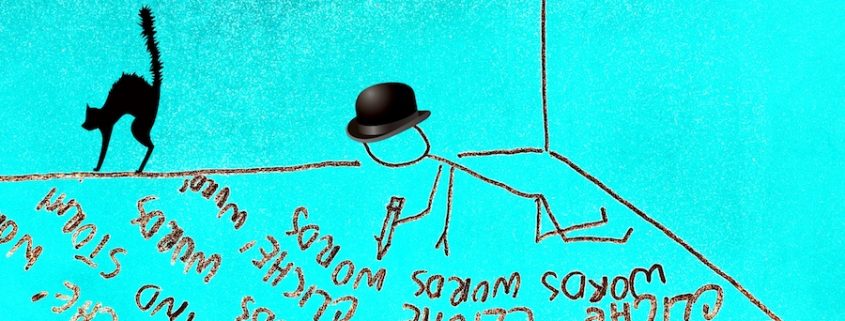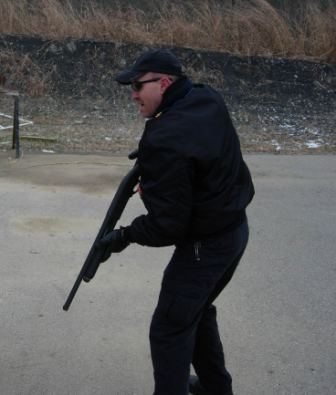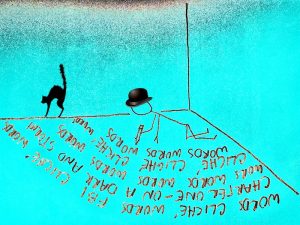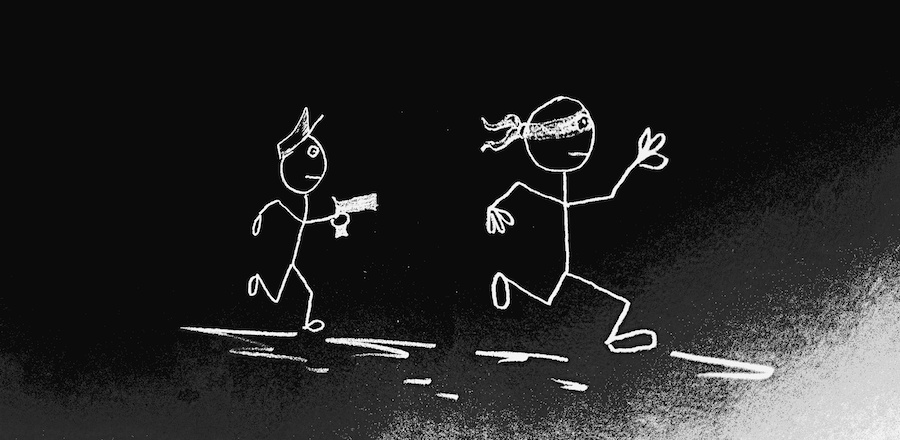It’s often the tiniest of details that’ll pique a reader’s interest in your work. Those elements, by design, just might make a lasting fan out of someone who recognizes that you’ve done your homework, and that you know how to subtly weave fact into fiction.
Like a well-rehearsed performance of Bugs Bunny at the Symphony II by The Philadelphia Orchestra, where we as concert-goers don’t see all the behind the scenes practice time that goes into scores such as The Rabbit of Seville, and Rhapsody Rabbit, a seasoned cop’s daily motions come with ease, as should the scenes you create where officers make arrests and carry out other duties that come with the job.
Cops perform certain tactics and techniques on a regular basis—handcuffing, using the car radio, pat-down searches, etc. They do these things so often that they could almost perform them in their sleep.
They rehearse tactics and techniques at the academy through role-playing. They practice what they’re taught, in their minds. They run through scenarios in their thoughts. All of this to prepare them for the big show—the encounter with that person or people who violently resist arrest, or those who simply want to hurt or kill a police officer.
That sense of “comes naturally” is the feel that fictional characters should exhibit on the page.
Detail, detail, detail
Living, breathing, pulse-pounding detail hooks the reader by thumping their hearts and increasing their respirations. Details that cause them to grip the book a bit tighter when the danger level is high and then reduces the tension when it’s done. It’s a rollercoaster ride that hinges on a writer’s ability to conduct a harmonious symphony of words, from the first moment through the last.
So, just as conductor George Daugherty and The Philadelphia Orchestra leads the audience on a speculator journey with Bugs Bunny, Daffy Duck, Elmer Fudd, Pepe Le Pew, Tweety, Sylvester, Wile E. Coyote, and the Road Runner, writers should compose their stories in a manner that leads the reader on an eye-popping emotional journey, a trip they want to take and won’t soon forget. 
Readers want writers to stimulate their senses. They want and need to know your characters on a personal level. And you definitely want readers to step into and immerse themselves into your carefully crafted stories. It’s an escape from reality that must begin with a passion to tell a tale.
Ask Yourself the Important Questions
So, in order to add those tiniest of important details needed to breathe true life into your cop characters, you should ask yourself a few basic questions, such as:
How should officers position themselves when making an arrest?
Answer– Always, always, always stand with their gun sides AWAY from the suspect. This is especially important when the subject is combative/resisting.
Which areas of an arrested subject should an officer search for weapons? Is there a standard procedure?
Answer – Start with the most obvious locations first—the waistband, of course, and this is especially so when dealing with male subjects. The waistband seems to be their go-to area of choice when concealing a weapon.
Each officer should establish a routine as to how they conduct searches of a person. By doing so the chance of missing an area is greatly decreased.
For example, after searching the waist and leg areas (boot knives and holsters are good hiding spots for weapons such as small guns and edged weapons).
For example, after first handcuffing the subject and then checking those main spots—the waist and leg areas (for guns and edged weapons), I moved to the top where I began the overall secondary, intensive search, starting beneath hats and working my way down until I reached the ground, leaving no area untouched, and that includes a firm hand in the groin area. This, believe me, is not the time to be shy. I’ve found more than one handgun and or/drugs hidden inside pants and underwear.
No item should be left in pockets and no portion of the body or clothing should be left untouched, including hair, mouth, hands (have them unclench closed fists, sleeves, torso, and socks and shoes!
Another point to note is that when officers hand over a suspect to another officer, the second/receiving officer should conduct another detailed search of the suspect. I know, it seems redundant, but it’s not worth risking your life by depending upon the potential sloppy search, or no search, by another human. Anyone, even the best of the best humans could make a mistake.
What are some of the danger signs officers look for when making arrests, or when simply speaking with suspects and some witnesses?
Answer – There are many, so I’ll mention only a few of the basics, such as:
A person wearing a coat during the summertime. This could indicate the subject is armed and is using the outer garnet to conceal the weapon. The same is true when a person touches an area on their waistband or moves a hand toward the area, or that a shirttail is untucked on one side. Or even when a person’s clothing “appears” a bit heavier on one side. Sometimes, the shape of a gun’s grips/an outline is noticeable beneath the material.
Pockets that appear heavier than normal. Sagging due to a heavy object inside could indicate the presence of a weapon. Keep in mind that even heavy objects such as rocks and bottles can and are used as instruments of death. Yes, a rock can kill, and has, when used with enough force.
Many, if not most of the “killed in the line of duty” deaths occur during an officer’s initial approach to a subject. This is why it is imperative that the officer quickly, almost within the blink of an eye, size up the person and then formulate a plan. Remember, no two situations are perfectly identical nor are two people the same in every way. So quick thinking and a plan are necessary.
It’s a given that it’s rude to not look someone in the eye when speaking to them. But eyes cannot hurt us. Therefore, officers should always, always, always watch the hands of a suspect/subject. Next, watch the feet. They, too, can be used as powerful weapons.
Still, a suspect’s eye movements often telegraph their next move, such as constantly glancing toward an officer’s sidearm may indicate the person could be planning an attempt to grab the gun. Or, they could searching for an avenue of escape or that a partner is sneaking up behind the officer’s back.
The combination of potential hazards explains the need for officers to forever scan their surroundings, Ambush attacks are common, and they’re deadly.
Officers should have a backup plan in case Plan A fails. And never hesitate to retreat if a situation becomes unmanageable and/or unsafe.
When in doubt call for backup!
How important is firearm maintenance?

GUANTANAMO BAY, Cuba – Coast Guard Gunner’s Mate 3rd Class Cameron Hutchens of Maritime Safety and Security Team (MSST) 91103, deployed to Joint Task Force Guantanamo, cleans an M-9 pistol.
Answer – Officers should maintain their weapons in excellent, tip-top condition. They should make certain that all firearms are clean, oiled, and operate properly. And they should practice their shooting skills on a regular basis. Shooting practice should include scenario-based training, not simply going to the range and popping 60 holes in a stationary paper target once each year during the required annual qualifying session. After all, how many times have you heard of an officer being killed by a non-moving sheet of paper?
The same is true of vehicles and other emergency tools and equipment. Maintenance and practice, practice, practice driving skills, as well as other tactics, such as building entries, etc. PRACTICE!!
What are some things that officers overlook when making an arrest?
Answer – Officers sometime become complacent. It’s easy to do when doing the same thing day after day after day. Unfortunately, when an officer is careless and, say, skips searching the crotch area of an arrested subject because he was too embarrassed to put a hand “there,” well, it could be the last mistake he’ll ever make when the guy reaches into his pants to retrieve a hidden .380.
Working Overtime and Second and Even Third Jobs
This isn’t so much “overlooking something” as it is being careless, but many officers often tend to work while excessively sleepy and/or tired. Their pay level is sometimes not so desirable so they work a lot of voluntary overtime to help make ends meet. Some even work second or third jobs.
When I worked at a sheriff’s office I also worked extra jobs. When I signed off after working night shifts I immediately drove to a motel where I worked another shift there performing maintenance work—repairing leaky pipes, painting, drywall, electrical work, etc. I attended classes, studied hard, and took and passed the test to become a licensed electrician. I also took care of all lawn maintenance and gardening. I did the same at a local college. And, I taught beginning, intermediate, and advanced guitar courses at the college.
Sometimes, on our days off, three of us deputies took on roofing jobs. We’d remove shingles and old paper on one day and haul them to the landfill after we’d finished (sometimes it was after dark when we were done). We’d then install new paper and shingles on the second day. It was exhausting and hot work. Making it even more tiring was that many times we were scheduled to work night shift after the second day of roofing work, or the night before the job was to begin.
I maintained this schedule for a few years, all while as a single dad. Yet, I made time to attend my daughter’s school functions and sports activities. She was a star softball player who was, during her high school years, recruited by the U.S. army to play ball for them. I can’t remember ever missing a home game, even if it meant attending in uniform with my ear glued to my radio.
I did the same (attend school function and games, etc.) when I left the sheriff’s office to work for a city police department. As a police detective, I attended many games with a gun and badge strapped to my belt with my unmarked car parked near enough that I could easily sprint to it, if necessary. I’ve left more than one game with blue lights winking and blinking and flashing.
Working a job where your life could be threatened at any time requires a person to be on top of his/her game. Working long, stressful hours with little sleep is not an idea scenario, but I, like many parents, did what I had to do to make certain my daughter had a roof over her head, clothes on her back, food in her belly, and shoes on her feet. I also practiced officer safety at all times to make certain she’d have a father.
Everything, Anyone, and Anything Could be Hazardous!
Overlooking the obvious is something that happens a lot. Just as I suggest to you that writing important details are, well, important, officers must take that to another level. For them, everything and everyone should be considered a danger until it’s proven that it’s not.
Hiding behind things such drywall and plywood works as concealment, but not as true cover. Bullets slice through both items as if they weren’t there. So find the best possible cover to protect against gunfire.
I’ve seen officers run to a downed man as if the danger ceased immediately once the suspect hit the dirt. NO!
This is an extremely perilous time. Always assume the suspect is still armed and capable of shooting and killing. Approach with caution, still using cover and concealment, if possible, until you’re certain the threat has ceased to exist. Keep in mind that the downed person may still have a hidden weapon and is pretending to be incapacitated.
Officers, never let down your guard. Not ever.
Finally, here’s Bugs to wrap up the day …
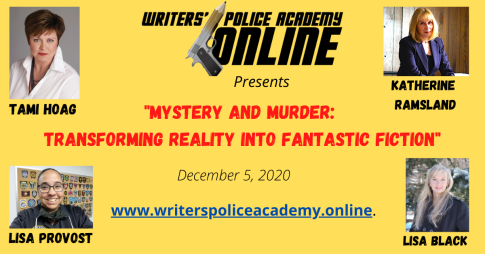
Don’t forget, the fabulous Writers’ Police Academy Online seminar takes place this Saturday, December 5th, 2020. Sign up today to attend this incredible live and interactive daylong session featuring acclaimed experts in their fields.
This is a unique opportunity that may never come your way again!



 Sleuthing the Clues in Staged Homicides – Instructor, Katherine Ramsland
Sleuthing the Clues in Staged Homicides – Instructor, Katherine Ramsland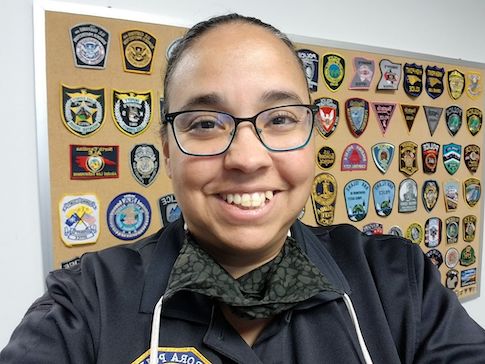 The Call You Get is Not Always the Call You Get: When a Routine Death Investigation Crosses State Lines and Multiple Jurisdictions – Instructor, Lisa Provost
The Call You Get is Not Always the Call You Get: When a Routine Death Investigation Crosses State Lines and Multiple Jurisdictions – Instructor, Lisa Provost  Not Just the Facts, Ma’am – Instructor, #1 International Bestselling Author Tami Hoag
Not Just the Facts, Ma’am – Instructor, #1 International Bestselling Author Tami Hoag





